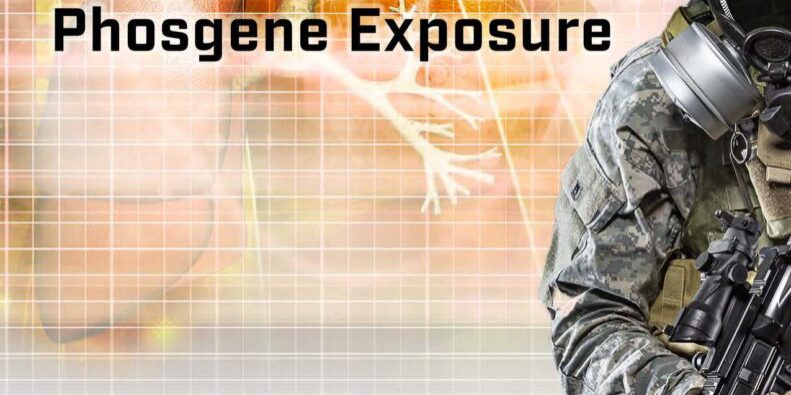Phosgene is a highly toxic choking gas that primarily injures an individual via the respiratory tract, e.g. the nose, throat, and particularly, the lungs. [1] Inhalation of phosgene results in a latent (up to 48 hours) pulmonary edema and irreversible acute lung injury, which can eventually lead to death. Phosgene toxicity caused about 80 percent of deaths among gas-induced casualties in World War I. [2]
Current treatment of phosgene poisoning focuses on managing symptoms, primarily removing the victims from the exposure and getting them into fresh air and rendering first aid. [1] Additional therapy involves administration of cortisone and sodium bicarbonate followed by the assistance of a positive airway pressure device. [1] Coughing can be suppressed with codeine. Antibiotic therapy is recommended if bronchitis develops. However, the availability of effective treatments is scarce, and mechanisms of phosgene induced lung injury remain unclear. There is currently no effective therapy to address the phosgene exposure itself.
The goal is to address this major gap and investigate a possible treatment using biocompatible and biodegradable polymer nanoparticles to treat phosgene injury to the lungs and understand the mechanism of action both at a cellular and a molecular level. The hypotheses is that the polymers with amine, ester and hydroxyl functional groups react with phosgene to yield non-toxic carbamoyl chloride, aldehyde and chloroformate, respectively. The products can be pumped directly to the systemic arterial circulation by an extensive capillary network in alveoli, [3] which facilitates the clearance of products by the reticuloendothelial system. Moreover, the suspicion is that by engineering polymeric nanoparticle geometry such as size and shape, researchers can
facilitate the intravascular delivery of products and blood circulation.
The work will focus on using five polymer nanoparticles that have been approved by the U.S. Food and Drug Administration, e.g., polycaprolactone, polylactic acid, poly(lactic-co-glycolic acid),
dextran and gelatin. An optimum nanoparticle size of approximately 150 nanometers diameter has shown highest blood circulation for the reticuloendothelial system clearance without causing any adverse effects in healthy lung cells. [4,5] The effects of nanoparticle shape and surface geometry on phosgene deactivation are largely unknown. The hypothesis is that non-spherical nanoparticles such as elongated rods or disks possess higher surface area to volume ratio than spherical nanoparticles, and therefore, can be more efficient than spheres in removing phosgene toxicity. The optimum nanoparticle design will be used for subsequent experiments.
Phosgene toxicity results in damage of the terminal alveoli and bronchiole in lungs. [6] Dose dependent nanoparticle and phosgene toxicities will be investigated in epithelial cells in vitro, and through animal studies. A range of nanoparticle doses (0-1000 ng/ml) and phosgene concentrations (0-10 ppm) will be exposed to cells. Toxicities will be measured by fluorescence intensity
of live and dead cells using a live/dead assay. It is expected that an optimally designed nanoparticle will remove phosgene from the lungs efficiently, and thereby enhance the mice survival rate.
Phosgene toxicity may induce cell-mediated immunity and humoral immunity derived from bronchial-associated lymphoid tissue and interstitial lymphocyte compartment within the lungs. Little is known about the role of cell signaling pathways in phosgene-induced lung injury. Inflammatory responses may induce the expressions of mitogen activated protein kinase and nuclear factor kappa B as it has been seen for a number of microbial stimuli. [7] Similarly, we hypothesize that MAPK and NF-κB expressions will be induced in response to inflammatory reactions by phosgene, but the protein expressions will be reduced down after the elimination of phosgene by optimally designed biocompatible polymer nanoparticles.
The inflammatory responses by phosgene will be tested using Western blot analysis. Phospho-specific p38 MAPK antibody and NF-κB p65 antibody expressions will be employed to confirm the change of proteins after exposure to phosgene in absence and presence of biodegradable polymer nanoparticles. β-actin will be used as a control. It is anticipated that the protein levels will be enhanced after phosgene exposure, but it will be suppressed to the basal level after eliminating phosgene by polymer nanoparticles.
References
1. Ganesan, K., Raza, S. K., & Vijayaraghavan, R. (2010). Chemical warfare agents. Journal of Pharmacy and Bioallied Sciences, 2(3), 166–178. http://doi.org/10.4103/0975-7406.68498
2. Fitzgerald, G. J. (2008). Chemical Warfare and Medical Response During World War I. American Journal of Public Health, 98(4), 611–625. ht t p : / / doi . org/10.2105/AJPH.2007.11930
3. Kent, C. (1998) Basics of Toxicology. Wiley.
4. Prokop, A. and Davidson, J. M. (2008), Nanovehicular intracellular delivery systems. J. Pharm. Sci., 97: 3518–3590. doi: 10.1002/jps.21270
5. Sung, J. C.; Pulliam, B. L.; Edwards, D. A.: Nanoparticles for drug delivery to the lungs. Trends in Biotechnology, 25, 563-570. doi: http://dx.doi.org/10.1016/j.tibtech.2007.09.005
6. Vaish, A. K.; Consul, S.; Agrawal, A.; Chaudhary, S. C.; Gutch, M.; Jain, N.; Singh, M. M. Accidental phosgene gas exposure: A review with background study of 10 cases. Journal of Emergencies, Trauma, and Shock 2013, 6, 271-275. Retrieved from http://www.ncbi.nlm.nih.gov/pmc/articles/PMC3841534/ (accessed July 5, 2016).
7. Mogensen, T. H. Pathogen Recognition and Inflammatory Signaling in Innate Immune Defenses. Clinical Microbiology Reviews 2009, 22, 240-273. Retrieved from http://cmr.asm.org/content/22/2/240.full.pdf+html (accessed July 5, 2016).


